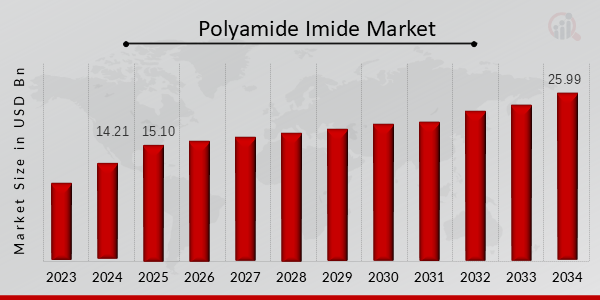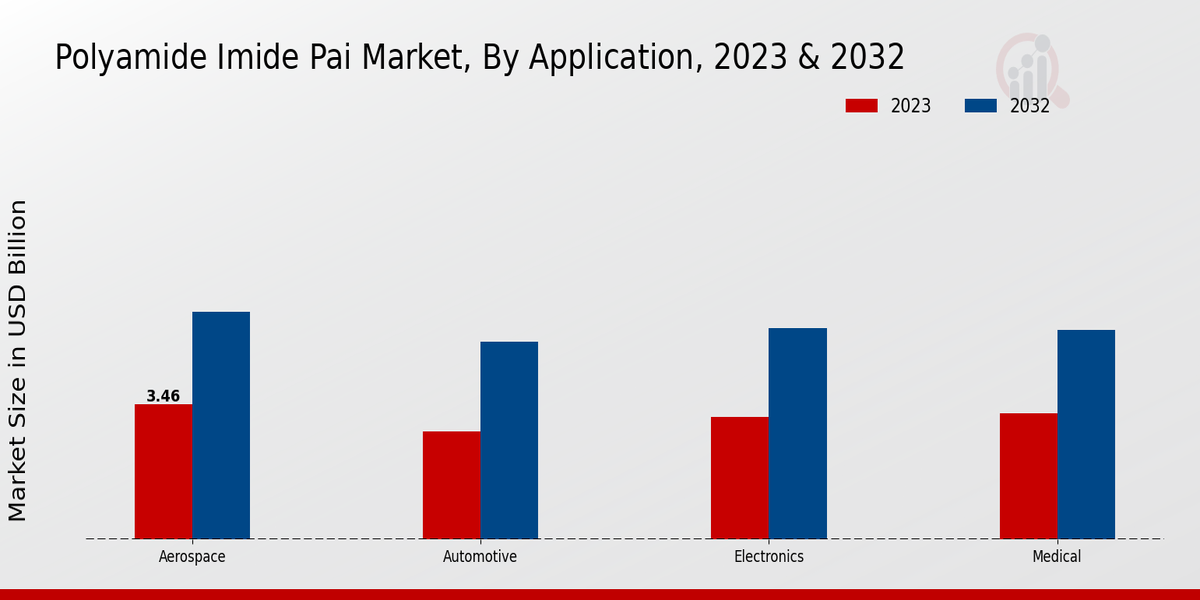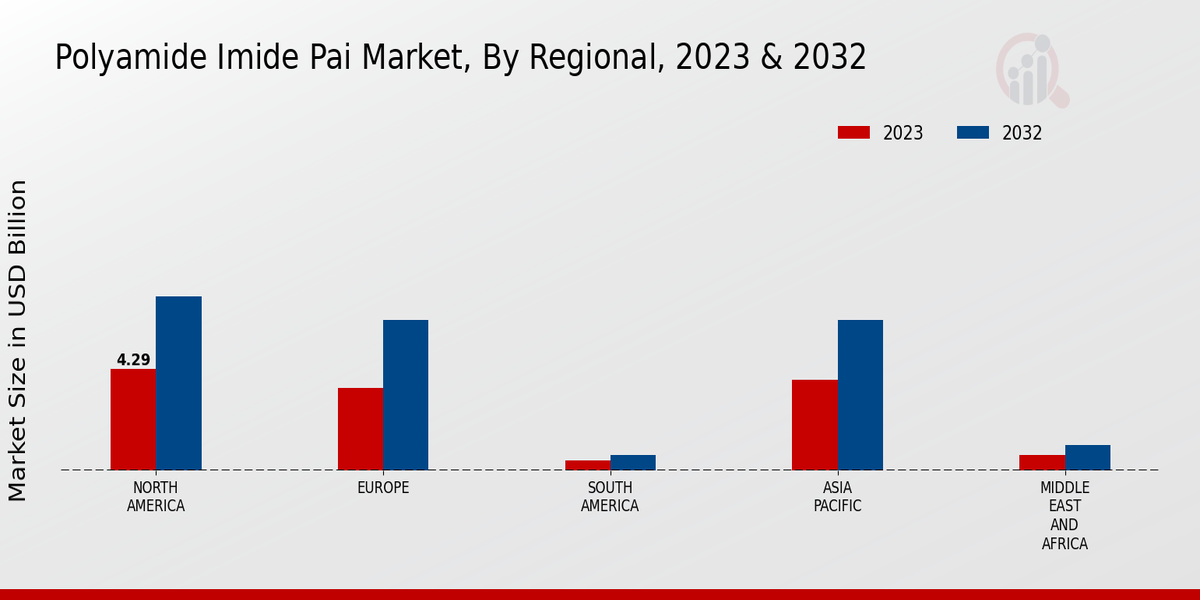Global Polyamide Imide PAI Market Overview
The Polyamide Imide PAI Market Size was estimated at 14.21 (USD Billion) in 2024.The Polyamide Imide PAI Industry is expected to grow from 15.10 (USD Billion) in 2025 to 25.99 (USD Billion) by 2034. The Polyamide Imide PAI Market CAGR (growth rate) is expected to be around 6.22% during the forecast period (2025 - 2034).
Key Polyamide Imide PAI Market Trends Highlighted
Asia polyamide-imide (PAI) market is removing geographical constraints owing to the development of space and time-compressed demand for PAI from regions where PAI was hitherto less utilized. The increasing number of smartphones, laptops, and electric vehicles in the market has had a positive impact on the growth of the electronics sector. As a result, PAI resins are being sought after because of their excellent electric and heat-insulating capabilities.
Also, the cut on the number of components in automobiles and efforts towards lightweight and fuel-efficient automobiles are underpinned by the need to utilize PAI, where the substance is warranted in engine parts and other hood applications.
There have been market changes in PAI that include creating new types of PAI that have additional features, for instance, better strength-to-weight ratio or increased temperature tolerance. Such improvements are slowly making the PAI more versatile in terms of practical application, especially in the aerospace and medical areas. In addition, environmental issues have shifted the emphasis of the PAI market towards marketable bio PAIs, which will change the market flow direction into a more commercially viable one.

Source: Primary Research, Secondary Research, Market Research Future Database and Analyst Review
Polyamide Imide PAI Market Drivers
-
Rising Demand for Lightweight and Durable Materials in Automotive and Aerospace Industries
The automotive and aerospace industries are increasingly adopting lightweight and durable materials to improve fuel efficiency and performance. Polyamide-imide (PAI) is a high-performance thermoplastic that offers a unique combination of strength, stiffness, and temperature resistance, making it an ideal choice for various applications in these industries.
In the automotive sector, PAI is used in engine components, electrical systems, and interior parts, where its lightweight and durability can contribute to improved fuel economy and overall vehicle performance.Similarly, in the aerospace industry, PAI is employed in aircraft components, such as engine nacelles, radomes, and interior panels, where its ability to withstand extreme temperatures and harsh conditions is crucial. The growing demand for lightweight and durable materials in these industries is a key driver for the growth of the global polyamide-imide (PAI) market.
Increasing Adoption of PAI in Electrical and Electronics Applications
The electrical and electronics sector is currently a major end user of PAI because this material has excellent electrical insulating characteristics. PAI materials are impervious to high temperatures. Electrical components that benefit from its unique properties are connectors, inserting switches, and printed circuit boards. That is, a very high voltage and temperature resistance is required here for long-lasting reliability. The demand for the miniaturization and the maximum functionality of electronic devices is growing in the world.For this reason, materials are required that can withstand extremely high electrical and thermal loads.
Growing Focus on Sustainability and Environmental Regulations
Rising sustainability consciousness combined with a constantly changing regulatory landscape with a growing accent on environmentally friendly solutions is driving the increasing demand for eco-friendly materials. While being a type of plastic, polyamide-imide is relatively sustainable compared to traditional polyethylene and other types of plastic, being able to be recycled and reused.
The material is also high-performing, which allows for the production of long-lasting and durable products.As time goes on, more governments and end customers alike tend to consider the environmental impact of their choices, and more and more sustainable materials are due to be adopted, thus likely leading to the growth of the polyamide-imide market in a global context.
Polyamide Imide PAI Market Segment Insights
Polyamide Imide PAI Market Application Insights
The Polyamide Imide PAI Market is classified into various applications such as aerospace, automotive, electronics, and medical. In 2023, the aerospace segment is expected to hold a dominant market share as the demand for lightweight and high-performance materials is rising in constructing of aircraft. The automotive segment is also expected to be a major contributor, as Polyamide Imide Pai is extensively being demand for the manufacturing of engine parts and interior trims.
In the electronics industry, Polyamide Imide Pai is emerging as a high-temperature resistant material that is also being used in printed circuit boards and electronic components.The medical segment is also a lucrative application as Polyamide Imide Pai is being used for manufacturing surgical instruments, medical devices, and implants. The market growth is attributable to the rising demand for lightweight materials in several industries and the increasing adoption of polyamide-imide pai in new applications.

Source: Primary Research, Secondary Research, Market Research Future Database and Analyst Review
Polyamide Imide PAI Market Product Type Insights
The Polyamide Imide PAI Market segmentation by product type includes Thermoplastics, Thermosets, and Composites. Among these, Thermoplastics held the largest market share of around 60% in 2023 and is projected to continue its dominance throughout the forecast period. This is attributed to their superior properties, such as high strength, stiffness, and thermal stability, making them suitable for various applications in the aerospace, automotive, and electronics industries.
Thermosets are expected to witness a steady growth rate during the forecast period due to their excellent chemical resistance and high-temperature performance, making them ideal for use in harsh environments.Composites, which combine the properties of both thermoplastics and thermosets, are gaining popularity in advanced applications such as lightweight structures and high-performance components, thereby contributing to the overall market growth.
Polyamide Imide PAI Market Properties Insights
The Polyamide Imide PAI Market is segmented by properties such as high-temperature resistance, high strength, and lightweight. These properties make it a valuable material for various applications in industries such as aerospace, automotive, and electronics. High-Temperature Resistance: Polyamide Imide Pai exhibits exceptional thermal stability, withstanding temperatures up to 250C (482F) for extended periods without significant degradation. This property makes it suitable for applications requiring high-temperature resistance, such as heat exchangers, engine components, and electrical insulation.High Strength: Polyamide Imide Pai possesses high tensile strength and modulus, making it a robust and durable material.
Its mechanical strength allows it to withstand significant loads and stresses, making it suitable for structural components in vehicles, machinery, and other demanding applications. Lightweight: Despite its high strength, Polyamide Imide Pai is relatively lightweight, offering a favorable strength-to-weight ratio. This property is critical for applications where weight reduction is essential, such as in aerospace components, automotive parts, and portable electronics.
Polyamide Imide PAI Market End-Use Industry Insights
The transportation segment held the largest share of the Polyamide Imide PAI Market in 2023, accounting for over 35% of the market revenue. The growth of the segment can be attributed to the increasing demand for lightweight and fuel-efficient vehicles. The construction segment is also expected to witness significant growth over the forecast period, owing to the rising demand for high-performance materials in the construction industry.
The industrial segment is expected to grow steadily, driven by the increasing use of polyamide-imide pai in various industrial applications such as electronics, machinery, and aerospace.In 2023, the Polyamide Imide PAI Market segmentation by End-Use Industry was valued at USD 2.6 billion and is projected to reach USD 4.9 billion by 2032, exhibiting a CAGR of 6.8% during the forecast period.
Polyamide Imide PAI Market Regional Insights
The Polyamide Imide PAI Market is segmented into North America, Europe, APAC, South America, and MEA. North America held the largest market share in 2023 and is expected to continue its dominance throughout the forecast period. The growth in this region can be attributed to the increasing demand for lightweight and high-performance materials in the automotive and aerospace industries. Europe is the second-largest market for Polyamide Imide Pai, followed by APAC.
The APAC region is expected to witness the fastest growth in the coming years due to the rising demand from the automotive and electronics industries.South America and MEA are expected to show steady growth over the forecast period.

Source: Primary Research, Secondary Research, Market Research Future Database and Analyst Review
Polyamide Imide PAI Market Key Players And Competitive Insights
Major players in the Polyamide Imide PAI Market are continuously striving to maintain their market positions by adopting various competitive strategies. These strategies include the development of new products, expansion into new markets, and acquisitions and mergers. Key players in the Polyamide Imide PAI Market industry are focused on improving the efficiency and performance of their products to meet the evolving demands of customers. Leading Polyamide Imide PAI Market players are also investing in research and development to create innovative solutions that can meet the growing needs of the industry.
The Polyamide Imide PAI Market development is driven by increasing demand from automotive, aerospace, and electrical and electronics industries.A leading company in the Polyamide Imide PAI Market is Solvay. The company offers a wide range of Polyamide Imide Pai products, including Torlon, Amodel, and Ixef. Solvay's Polyamide Imide Pai products are known for their high performance and reliability and are used in a variety of applications, including automotive, aerospace, and industrial. Solvay has a strong global presence, with manufacturing facilities in Europe, Asia, and North America.
The company is also investing in research and development to develop new Polyamide Imide Pai products and applications.A competitor company in the Polyamide Imide PAI Market is RTP Company. The company offers a range of Polyamide Imide Pai products, including Vestamid and RTP 300 series. RTP Company's Polyamide Imide Pai products are known for their high strength and durability and are used in a variety of applications, including automotive, aerospace, and electronics. RTP Company has a global presence, with manufacturing facilities in North America, Europe, and Asia.
The company is also investing in research and development to develop new Polyamide Imide Pai products and applications.
Key Companies in the Polyamide Imide PAI Market Include:
Polyamide Imide PAI Market Industry Developments
The market growth is primarily driven by the increasing demand for lightweight and high-performance materials in various industries, including aerospace, automotive, and electronics.Recent developments in the PAI market include the launch of new products with improved properties and the expansion of production capacities by key players. For instance, in 2023, Evonik Industries introduced a new PAI grade, VESTAKEEP iQ 1000, which offers enhanced toughness and ductility for demanding applications. Additionally, Toray Industries announced plans to invest in a new PAI production plant in Japan, scheduled to start operations in 2025.
These developments indicate the ongoing commitment of industry participants to meet the growing demand for PAI.
Polyamide Imide PAI Market Segmentation Insights
-
Polyamide Imide PAI Market Application Outlook
-
Polyamide Imide PAI Market Product Type Outlook
-
Polyamide Imide PAI Market Properties Outlook
- High-Temperature Resistance
-
Polyamide Imide PAI Market End-Use Industry Outlook
-
Polyamide Imide PAI Market Regional Outlook
| Report Attribute/Metric |
Details |
| Market Size 2024 |
14.21 (USD Billion) |
| Market Size 2025 |
15.10 (USD Billion) |
| Market Size 2034 |
25.99 (USD Billion) |
| Compound Annual Growth Rate (CAGR) |
6.22% (2025 - 2034) |
| Report Coverage |
Revenue Forecast, Competitive Landscape, Growth Factors, and Trends |
| Base Year |
2024 |
| Market Forecast Period |
2025 - 2034 |
| Historical Data |
2020 - 2024 |
| Market Forecast Units |
USD Billion |
| Key Companies Profiled |
Kuraray, Hyosung Corporation, DuPont, Evonik, Solvay, Lanxess, Teijin, BASF, Toray Industries, Kolon Industries, Mitsubishi Chemical, SABIC, Asahi Kasei, Sumitomo Chemical |
| Segments Covered |
Application, Product Type, Properties, End-Use Industry, Regional |
| Key Market Opportunities |
Aerospace composite applications, Automotive lightweight components, Oil and gas downhole tubing, Biomedical implants, Electronic packaging |
| Key Market Dynamics |
Growing demand for lightweight materials Rising demand in aerospace applications Increasing adoption in automotive industry Expanding use in electrical and electronics sector Advancements in manufacturing technologies. |
| Countries Covered |
North America, Europe, APAC, South America, MEA |
Frequently Asked Questions (FAQ):
The global Polyamide Imide (PAI) market was valued at approximately USD 14.21 billion in 2024 and is expected to reach USD 25.99 billion by 2034, exhibiting a CAGR of 6.22% during the forecast period.
North American region is anticipated to dominate the global PAI market throughout the forecast period due to increasing demand from the automotive and aerospace industries in the region.
PAI finds applications in various industries, including automotive, aerospace, electrical and electronics, and oil and gas. In the automotive industry, PAI is used in components such as engine parts, brake systems, and fuel lines.
Major players in the global PAI market include Evonik Industries, Solvay, BASF, Quadrant, and Ensinger. These companies offer a range of PAI products and solutions to cater to the diverse needs of end-use industries.
The market growth is driven by factors such as increasing demand for lightweight and high-performance materials in the automotive and aerospace industries, rising adoption of PAI in electrical and electronics applications, and growing awareness of PAI's unique properties, including its high-temperature resistance, chemical resistance, and wear resistance.
The market growth may be restrained by factors such as the high cost of PAI compared to traditional materials and the limited availability of PAI suppliers, leading to potential supply chain disruptions.
The global PAI market is anticipated to witness steady growth over the forecast period, with a CAGR of 6.22% from 2025 to 2034.
Emerging trends in the market include the development of bio-based PAI, the integration of PAI with other materials to enhance performance, and the adoption of advanced manufacturing technologies to improve production efficiency.
The COVID-19 pandemic had a moderate impact on the PAI market. While the automotive and aerospace industries experienced a decline in demand, the electrical and electronics segment remained resilient, contributing to the overall market growth.
Opportunities for growth in the market lie in the expansion of the automotive and aerospace industries in emerging economies, the increasing adoption of PAI in renewable energy applications, and the development of new PAI grades with enhanced properties.
















